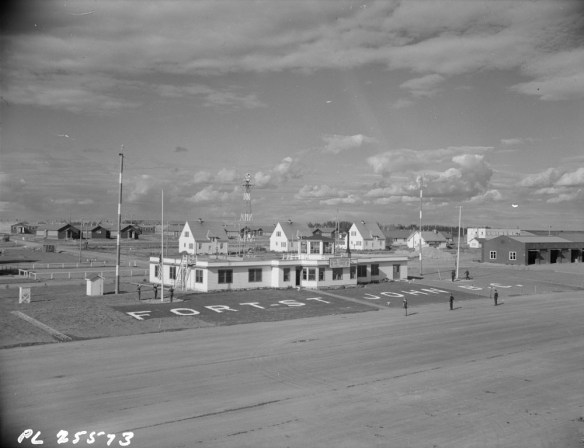By Caitlin Webster
British Columbia joined Canada 150 years ago, and in the years that followed, federal infrastructure expanded throughout the province. This infrastructure is well documented throughout Library and Archives Canada’s collections. This eight part blog series highlights some of those buildings, services and programs, as well as their impact on B.C.’s many distinct regions.
Public airports have been a constant in Canada since the 1920s, when purpose-built facilities replaced the rudimentary airfields and landing strips of the early days of flight. However, the Second World War led to a marked increase in civilian and military airport construction.
In the late 1930s, the Department of Transport constructed a basic airfield in Fort St. John, British Columbia. Located on the traditional territories of the Treaty 8 First Nations, the airfield served as part of a transport route through Grande Prairie, Fort St. John, Fort Nelson, Watson Lake and Whitehorse. When the United States entered the Second World War in 1941, this route offered a strategic location for transportation to Alaska, and for the construction of the Alaska Highway. As a result, in 1943 the U.S. Air Force completely rebuilt the airport in Fort St. John, with resurfaced runways, new fuel facilities, hangars, barracks and accompanying buildings.

Administration building at RCAF Fort St. John, B.C. (e011309348)
RCAF Fort St. John opened in 1943, with personnel performing such duties as maintaining runways and buildings, facilitating incoming and outgoing flights, and monitoring weather conditions. Personnel at the detachment were involved in flights to help the Halfway River First Nation during a 1949 diphtheria outbreak by airdropping supplies of anti-toxin, and by airlifting individuals to medical centres for treatment.
Staff at the detachment also participated in popular outdoor activities in the area, such as picnics, swimming, hunting and fishing. In addition, the station organized teams to play in local amateur sports leagues, including baseball and hockey. However, in the summer of 1948, a polio outbreak in the area forced the station to cancel many of these activities. Certain sections of the station itself were quarantined from July to September of that year due to polio outbreaks among staff.

Page from Royal Canadian Air Force operations record books, including a note indicating the cancellation of Air Force Day due to a local polio outbreak (RG24-E-7; image found on Heritage Canadiana)
By 1950, activity at the station was winding down, and on October 1, 1950, RCAF Fort St. John was officially disbanded. The RCAF funded its maintenance costs until March 31, 1951. In April 1951, it transferred responsibility for the airport to the Department of Transport. Today, the North Peace Regional Airport serves as an important gateway for business and tourism in the area.
To learn more about RCAF Fort St. John, check out the Royal Canadian Air Force operations record books, which contain details of daily duties, flying operations, events and social activities for various units. Microfilm copies of the records are available online, including entries for RCAF Fort St. John on reels C-12185 and C-12399.
Caitlin Webster is a senior archivist in the Reference Services Division at the Vancouver office of Library and Archives Canada.

